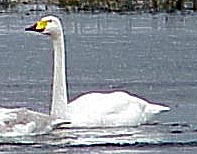Whooper Swan
White Lake Unit, Lower Klamath National Wildlife Refuge, Siskiyou County, California
9-10 March 2001
Joseph Morlan
 Robbie Fischer and I decided to spend
a few days at the Lower Klamath National Wildlife Refuge searching for raptors and waterfowl. We arrived at White
Lake (Stateline Road at the Merrill turnoff) late on Friday and were pleased to see one of the adult Whooper Swans
there with a group of 7 Tundra Swans. When we arrived, Wayne Hoffman from Portland had already located the bird.
We also met Dave Haupt, formerly from the Monterey area now living in Klamath Falls who advised us that he had
seen two adults and three immature Whooper Swans at this site in recent days. On Saturday morning we encountered
Ed Harper, Ed Greaves and several other birders, mostly from Sacramento. The Whooper Swan had moved further east,
but was still with the same flock at White Lake. Later Mike Mammoser located the other Whooper Swan with the three
young at another section of the Lower Klamath refuge.
Robbie Fischer and I decided to spend
a few days at the Lower Klamath National Wildlife Refuge searching for raptors and waterfowl. We arrived at White
Lake (Stateline Road at the Merrill turnoff) late on Friday and were pleased to see one of the adult Whooper Swans
there with a group of 7 Tundra Swans. When we arrived, Wayne Hoffman from Portland had already located the bird.
We also met Dave Haupt, formerly from the Monterey area now living in Klamath Falls who advised us that he had
seen two adults and three immature Whooper Swans at this site in recent days. On Saturday morning we encountered
Ed Harper, Ed Greaves and several other birders, mostly from Sacramento. The Whooper Swan had moved further east,
but was still with the same flock at White Lake. Later Mike Mammoser located the other Whooper Swan with the three
young at another section of the Lower Klamath refuge.
The following description is based on notes made while observing the bird. On Saturday I was afforded very fine views through a borrowed Questar.
An all white swan, slightly larger than the average Tundra Swan, but not noticeably larger than the largest Tundra. When the birds were feeding with necks under the water, it was impossible to predict which one was the Whooper. The most notable feature was the wedge of bright yellow at the base of the bill. This yellow color extended all the way down to the gape and out to a point beyond the nostril. From the side it seemed to connect across the culmen, but when viewed with the Questar I was able to see dark extending between the yellow plates all the way to the forehead. The pattern of dark and yellow on the sides of the culmen was somewhat ragged. The lower mandible was black with an obvious yellow stripe extending down the middle, almost reaching the tip on the underside of the bill.
Also a dark line extended forward from the eye, separating the yellow plates from the white feathering on the forehead. The forehead feathering was rounded, and did not extend forward into a point as on adult Trumpeter Swans, but the extension of white on the cheek, seemed quite straight, not bulging forward as on most adult Tundra Swans. The eyes and feet appeared black.
Discussion
The suggestion that our bird might be a hybrid was made. The main problem stemmed from the overall size of the bird which was not as massive as expected. The other Whooper Swan was said to be obviously larger with even more yellow on the bill. I believe there is considerable intraspecific size variation in all swans, and was unable to detect any further evidence of hybridization. I would expect a hybrid would probably have a more intermediate bill pattern.
These birds are believed to be the same individuals seen at Summer Lake, Oregon, and at least one of these birds has returned to White Lake for several years.
Added 4 April 2001
Another Whooper Swan photographed at White Lake 19 February 2001 appears to be of the larger bird with more extensive yellow on the bill.
[Home]